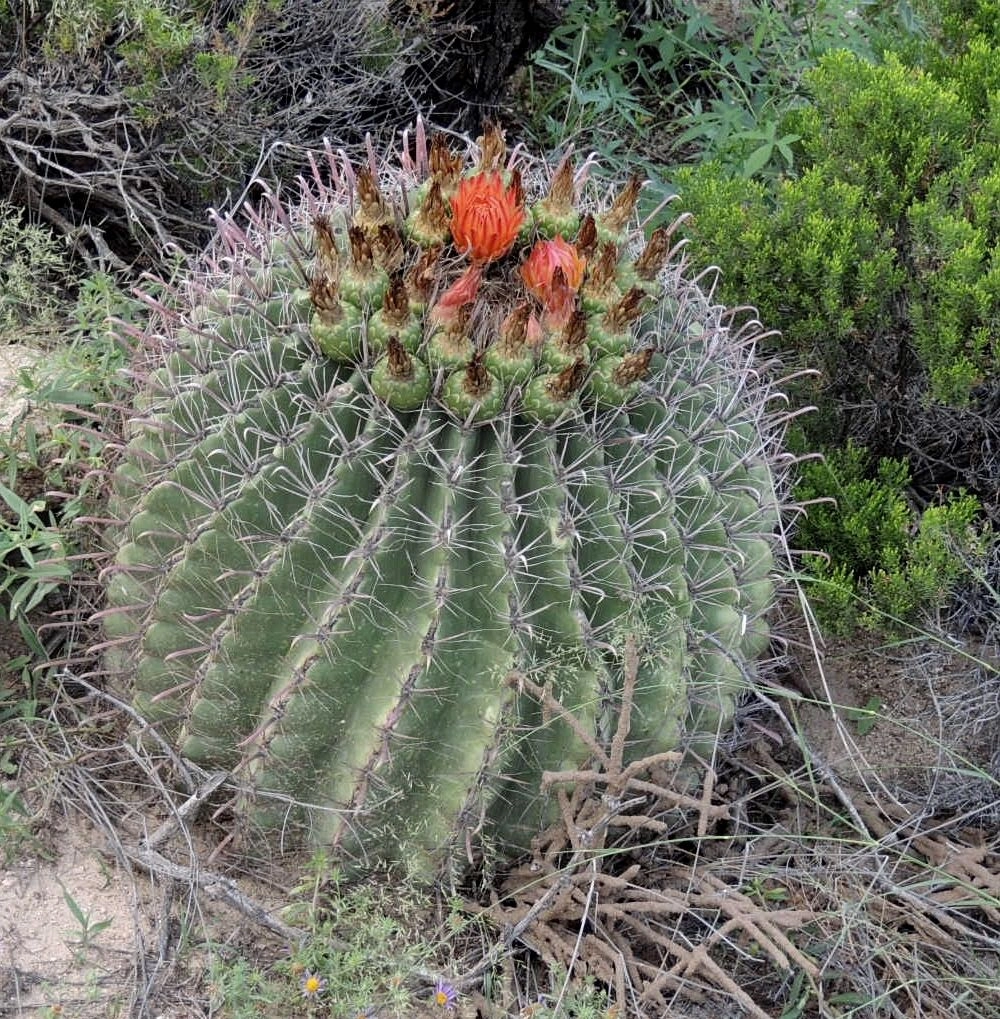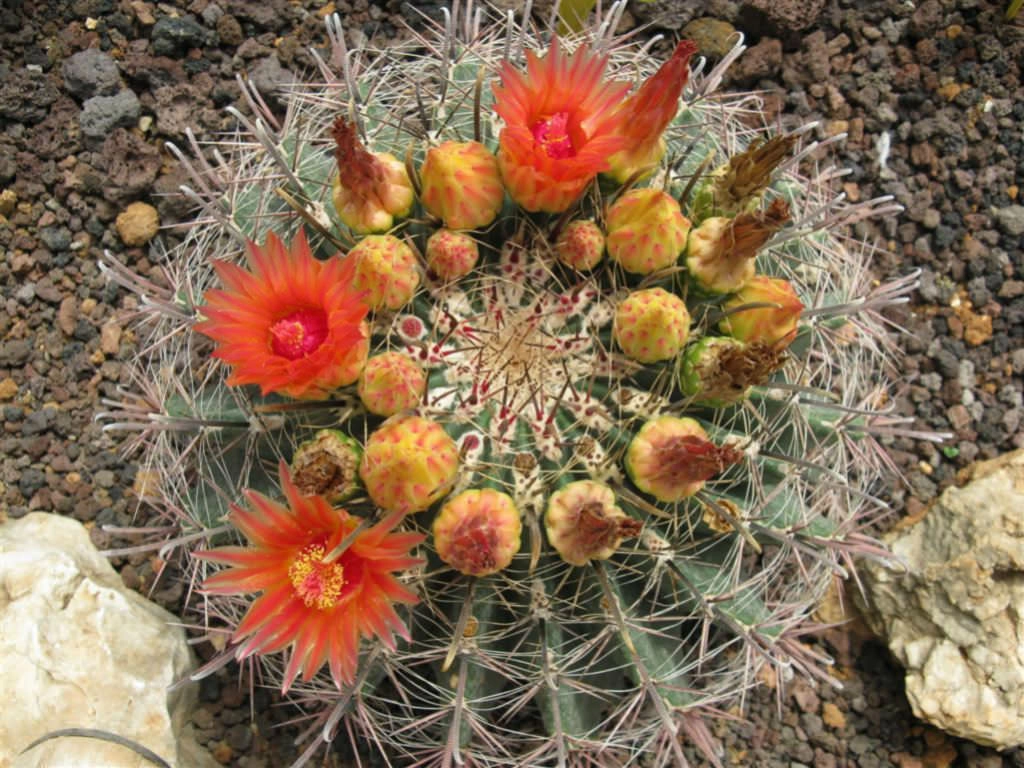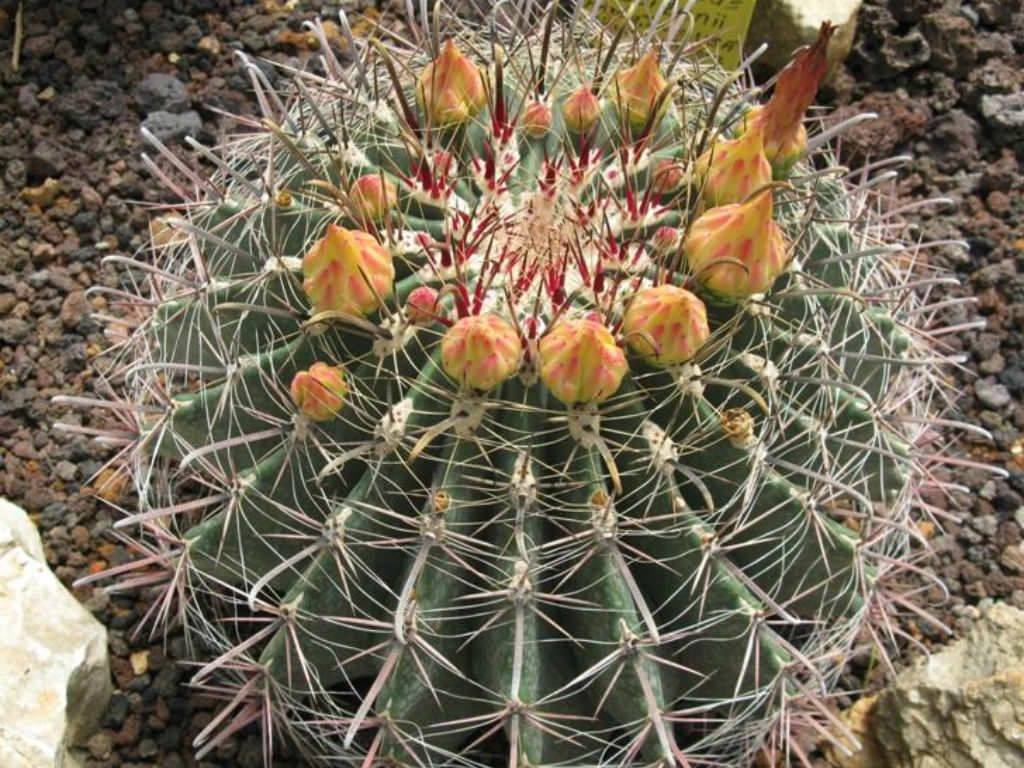Fishhook Barrel Cactus is known as the Ferocactus wislizenii. Commonly it is a cylindrical-looking ribbed cactus native to the deserts of Southern-central Arizona.
Fishhook Cactus grows up to varying sizes. Commonly, these cacti grow up to 3-5 feet tall but can also grow taller thereby reaching a height of 5-10 feet. The cactus width also ranges from being 2 feet to about 5 feet.
The Arizona Barrel Cactus has long spines in the form of hooks and has reddish or yellowish flowers followed by bright yellow fruit formation at its top.
These cacti plants require bright sunlight and less humid places for healthy growth. Thus, if your place matches their physical conditions or you can make suitable artificial arrangements then you can easily grow such cacti.
Caring for the Fishhook Barrel Cactus is quite easy and hence can be easily grown by novice gardeners.
Why it’s called Fishhook Cactus?
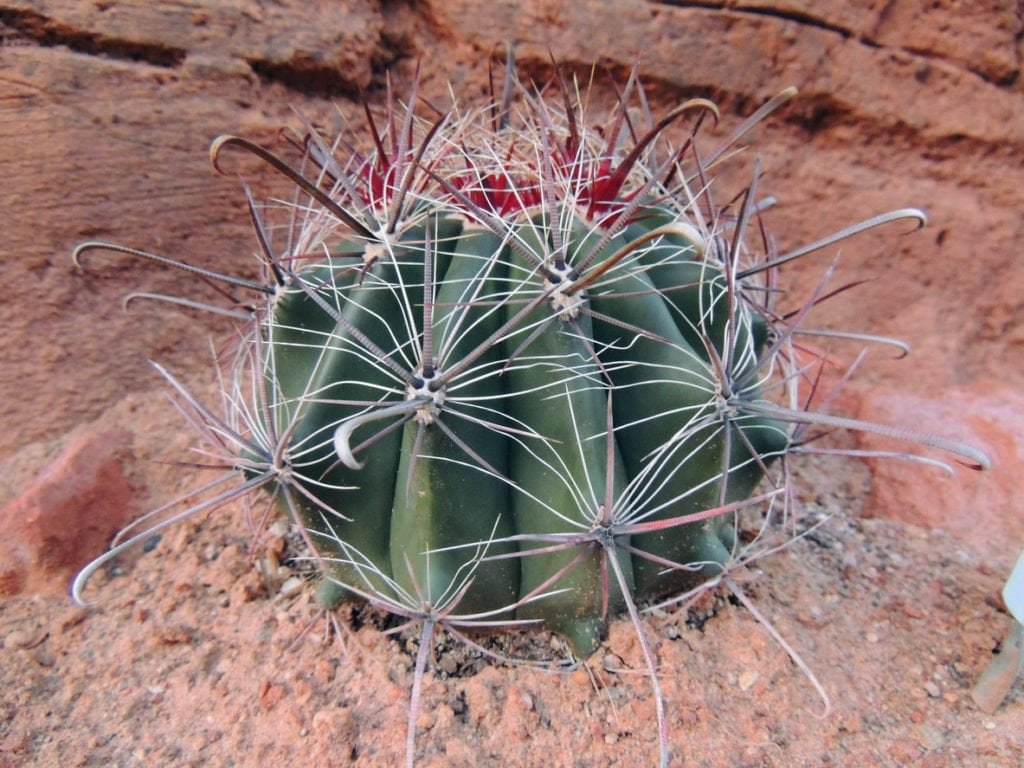
Ever wonder why this Arizona Barrel cactus is called Fishhook Cactus?
It’s easy, check out the above picture. Do you see the curvy spine of the cactus? Isn’t it resemble a fishhook? Amazing!
Identification of Fishhook cactus
What does a fishhook barrel cactus look like?
Arizona Barrel Cactusbelongs to the species of hooked spines in the family of Cactaceae.
Ferocactus wislizenii can be identified by their barrel-shaped or cylindrical-shaped body covered with long hooked-shaped spines.
These cacti later grow to blossom with yellow or red flowers followed by yellow fruit formation at the top.
How long does the cactus live?
The Barrel Cactus has an average life span of 45-100 years.
Types of Barrel Cactus
Do you want to know more about the barrel cactus?
The types of barrel cactus with their characteristics are listed as follows:
Colville’s barrel (Ferocactus emoryi)
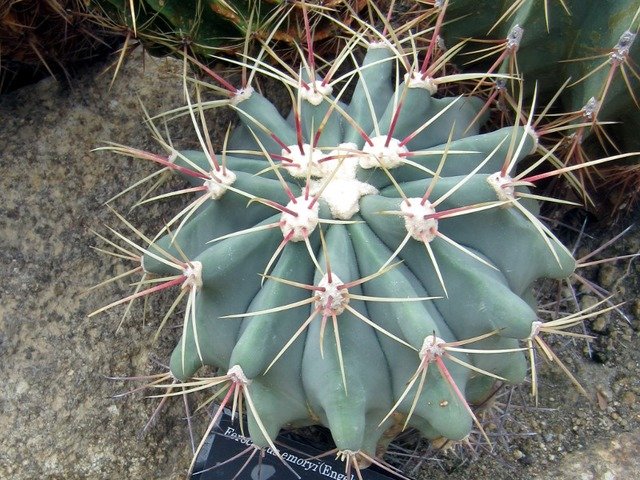
Colville’s barrel commonly known as Ferocactus emoryi is a cylindrical cactus having a height of 3 feet and a width of about 2 feet. The cactus is native to the Sonoran desserts.
The cactus loves bright sunlight and grows the best in well-drained soil.
This cactus blooms during spring and summer, and hence good care of the cactus must be taken during this period to welcome crimson red or orange, or yellow flowers followed by juicy yellowish fruit formation at the top.
Blue barrel (Ferocactus glaucescens)
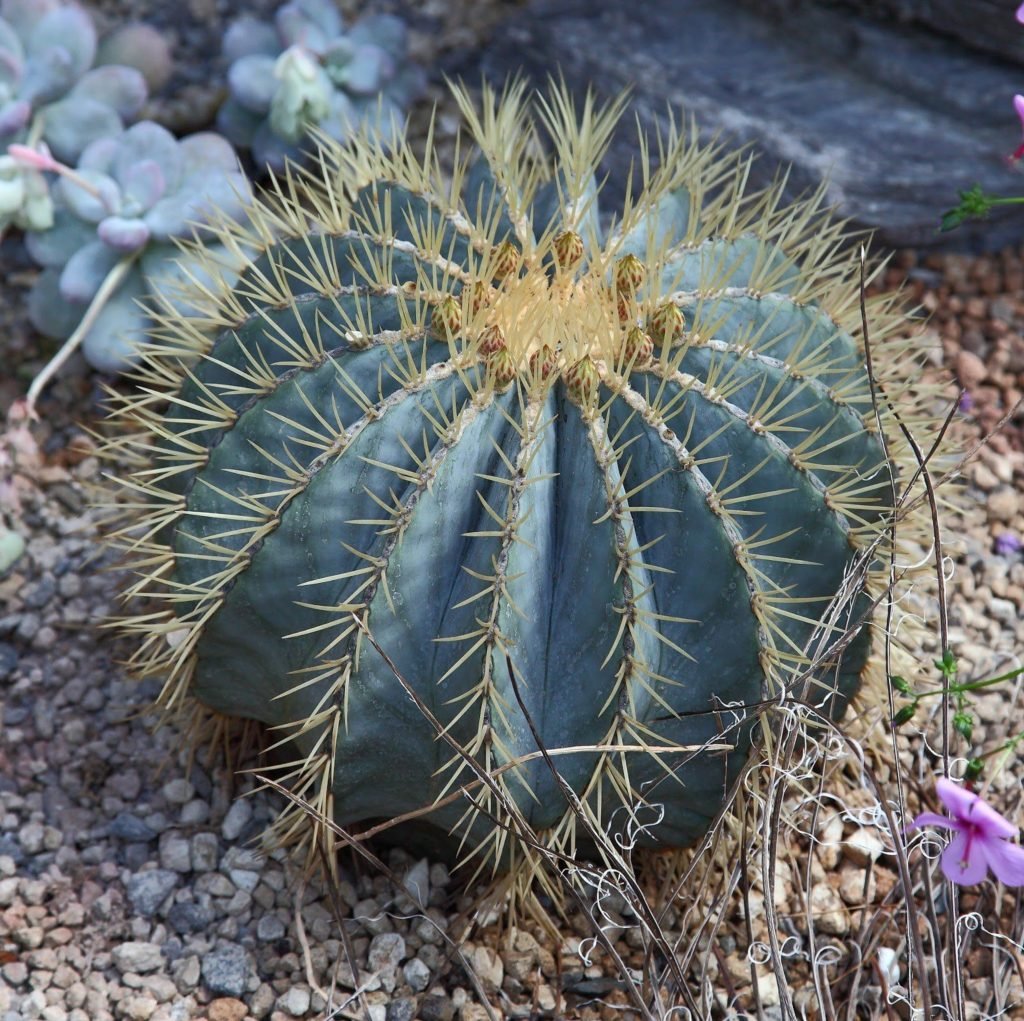
The blue barrel is also known as Ferocactus glaucescens and it is a 2 feet tall bluish or greenish-colored cylindrical cactus with lime-colored spines native to the deserts of Central Mexico.
The cactus loves bright sunlight and grows the healthiest in well-drained soil.
The cactus blooms in spring or late summers, thereby forming yellow-colored funnel-like flowers followed by the formation of long white fruits at the top.
Golden Barrel (Echinocactus grusonii)
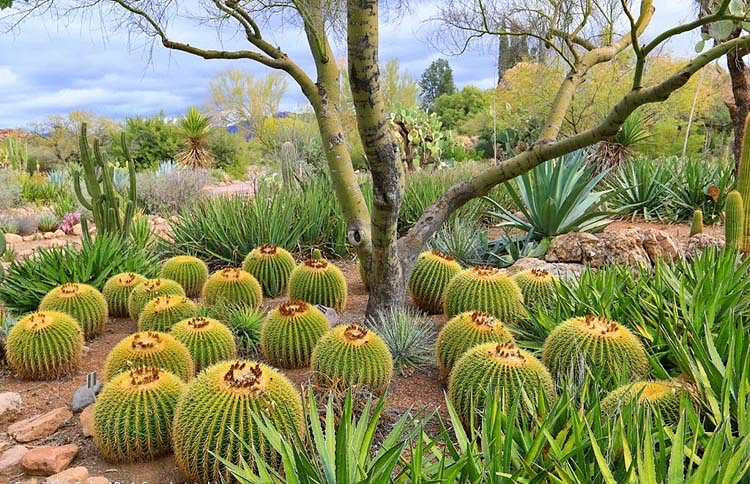
The golden barrel is also known as Echinocactus grusonii and it is a cylindrical cactus with a height of 5 feet and a width of 3 feet. The cactus is native to the deserts of Central Mexico. At present, this cactus is endangered in its natural environment.
Just like other cacti, this cactus also loves bright sunlight and well-drained soil.
The cactus blooms in summers with yellow flowers followed by the formation of lime-colored fruit at the top.
California barrel (Ferocactus cylindraceus)
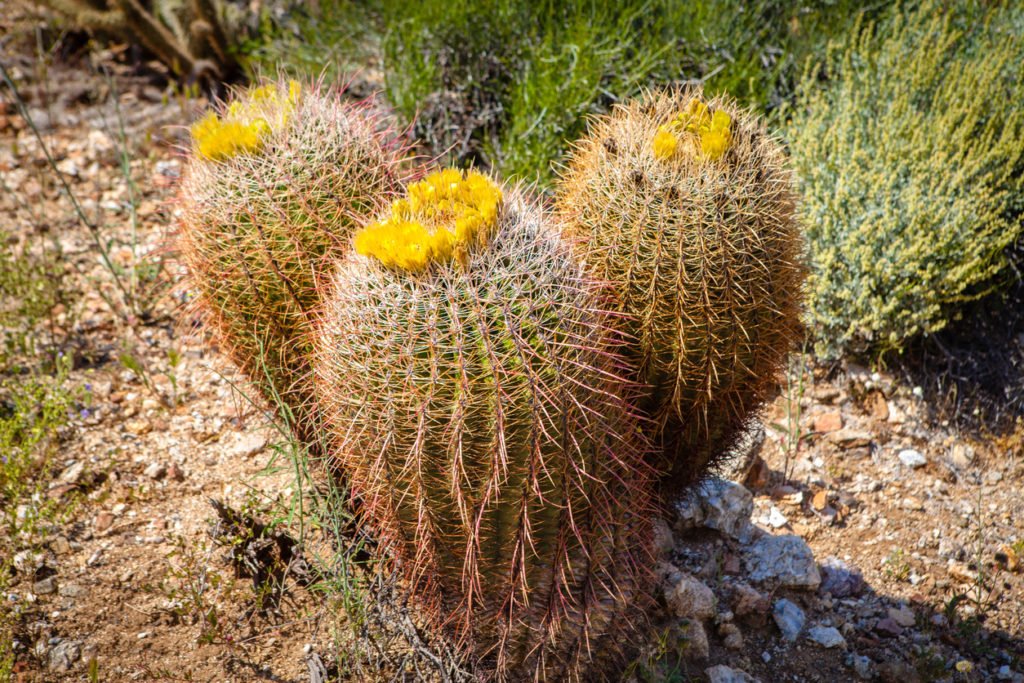
California barrel is also known as Ferocactus cylindraceus and it is a spherical cactus with a height of 8 feet and a width of about 2 feet. The cactus is native to the Sonoran and Mojave deserts.
The cactus grows best in bright sunlight and well-drained dirt.
The cactus blooms in summers or late springs, with yellow flowers followed by the formation of bright yellow fruit at the top.
Caring for the cactus
The Ferocactuscan be grown both as a houseplant as well as an outdoor plant in dry gardens.
Just like other cacti, these cacti also require less water and bright sunlight.
Let us see the parameters important for the proper caring of the Fishhook Cactus:
Temperature and humidity
The cactus ideally prefers a warm and dry place.
But, it can withstand quite some heat with the temperature rising to about 45F provided the humidity is low.
If the place lacks low humidity then great care must be taken with the watering schedule of the plant.
Moreover, despite having such preferences the Arizona Barrel Cactus does grow well in normal household conditions as well.
Watering
The watering schedule for Ferocactus wislizenii is quite infrequent.
Spring is the blossoming season for this cactus; hence, it needs once a week watering so that due to adequate watering the cactus blooms with bright orange or red, or yellow flowers. This flowering is followed by the formation of inedible yellowish fruits.
The same watering schedule is followed during summer.
In winters, the Fishhook Barrel Cactus stays dormant. It requires watering once in one or two months.
Moreover, before watering check whether the soil is completely dry or not. Make sure, that after watering the cactus, the water is completely drained out and no water is present even in the saucer.
Sunlight
The Fishhook cactus has healthy growth in sunny places. But, make sure not to provide direct sunlight, or else the cactus may get burned.
If enough sunlight is not provided to the cactus then it will have slow growth and will die soon.
If grown as a houseplant, grow it near windows receiving bright sunlight.
And, if the Fishhook Barrel Cactus is grown in dry gardens then make sure to acclimate the plant and grow it in high sunlight receiving place.
Soil requirements and fertilizing
Cactus soil mix sold in the boutiques or nurseries is ideal for the proper growth of Ferocactus wislizenii.
Instead of buying the soil mix, we can even make a by mixing 2 parts of commercial native soil mix with 1 part of perlite and 1 part of sand and gravels.
For better water drainage, we can increase the ratio of the perlite in the soil mix or make separate pebbles and gravels layer at the bottom of the pot.
For fertilizing the cactus, we need to use fertilizers with a high potassium content.
Propagation of the cactus
The Arizona Barrel Cactuswhen matures up blooms with yellow or red or bright orange flowers at the top during spring or summer. This is followed by the fruit formation where yellow fruits with black seeds are formed.
With the seeds received we can propagate the cactus. For that, we need to plant the seeds in a cactus mix in such a manner that they remain warm and slightly moist.
We can even propagate the cactus with the help of the pups or baby plants sprouted at the base of the parent cactus.
Remove the dirt from the pup and slice the baby plant away from the parent plant using a sharp and sterilized knife.
Let the pup dry for a day or two and wait till it shows a slight callus formation. Plant the pup in a new pot with fresh cactus soil mix and water it immediately.
After that, water the plant after the formation of baby roots. Know more on propagation here.
Potting and re-potting
For potting, we can either grow the Ferocactus wislizenii from the seed or we can purchase a baby cactus.
The pot should be quite large embedded with purchased or homemade cactus soil mix.
The cactus should be re-potted after a few years during the growing season.
We need to make sure that the soil is dry before we extract the cactus from the pot. The extraction must be done carefully and we need to wear thick gloves to avoid getting pricked by a spine.
Clean the cactus off any dirt or dead roots. If there are some wounds, then treat those with fungicide.
Now, place the cactus by spreading its roots in a large pot with fresh cactus soil mix. Start watering the cactus after a week to avoid any root rot.
These Fishhook Cactus can be bought online today, very easily and quickly through Amazon.
Blossoming of the cactus
The ideal blooming period for the Fishhook cactus is during spring and summer.
Hence, great care must be taken during this period by providing the cactus with adequate sunlight and water.
Bright orange or yellow or red flowers bloom at the top of the cactus followed by the formation of lime-coloured or yellow-colored fruits with black seeds that easily fall off.
The appearance of the flowers and the fruits increases the aesthetic value of the cactus. Moreover, this cactus is well known for its beautiful flowers and fruits.
The correct way of Watering Cactus
Cacti do store water. But, the water stored in most cacti is not fit for human consumption, especially on empty stomach.
Most cacti, to protect their fleshy leaves secrete acids and alkaloids. Hence, the water stored in them has quite a strong concentration of acid and base. Thus, the consumption of such water may result in diarrhea.
The safest of all the cacti for water consumption is the prickly pear and Fishhook cactus.
Fishhook barrel cactus wateris the most suitable for consumption as compared to other cacti water.
But still, consumption of the water on an empty stomach should be avoided as it might lead to diarrhea and body pains.
Now, how to get water from fishhook barrel cactus?
Or are you wondering how to drink from a fishhook barrel cactus?
We need to squish the cactus meat to extract water.
Be careful, since the cactus meat can be quite sticky to handle.
Cut the fleshy pad from the cylindrical cactus body and then wrap it with a thick cloth. Squeeze and wring the cloth to extract water from the fleshy pad.
The cactus’s water might be safe to consume still it is advised to take a few sips of the water only.
The yellow juicy fruit of the cactus that ripens in November can also be consumed which will work for both hunger and slight thirst.
The most important thing is that avoid starting a dessert trip without making arrangements for water consumption.
Problems and solutions
1. Freezing temperature
The Arizona Barrel Cactusgrows the best in warm places and is not a fan of low temperatures.
If the cactus is exposed to freezing or low temperature then it will suffer damage and the skin can turn yellow.
So, what is the solution?
Move the damaged cactus to a warmer place where the cactus may receive an adequate amount of sunlight to recover the damage.
2. Sunburn
The Fishhook Barrel Cactus loves bright sunlight but too much direct sunlight can make the cactus sunburned.
Mostly, the direct sun rays during the afternoon are harmful to the cactus.
When the cactus gets sunburned then yellow-colored patches may form on the cactus.
Now, what is the solution?
Move the cactus to a shady area where the cactus also receives an adequate amount of sunlight.
To avoid the damage first-hand, acclimate the cactus.
3. Fungal disease
The shaded Fishhook Barrel Cactus is vulnerable to fungal attack by the Pythium genus during the rainy seasons.
The fungal attack causes the formation of yellow or brown patches on the cactus skin and it may even result in root rotting.
Now, how to solve the issue?
We can solve the issue by moving the cactus to a drier place. We should also keep the soil dry to prevent any further fungal attacks.
You can also use Neem oil, an organic insecticide, and fungicide.
Toxicity to children and animals
The flowers and fruits of the Fishhook Barrel Cactus are non-toxic to children and animals.
But the pets and the children should be kept away from the cactus because of the prickly spines. If they get pricked by the hooked spines, then they will face extreme pain followed by irritation.
Curtains Down
The Ferocactus wislizenii is a great cactus to be grown by novice gardeners or people with a tight schedule as taking care of the cactus is not at all hectic.
The cactus can be easily purchased from online boutiques or nearby nurseries.
The cactus enhances the look of the place with its beautiful structure and once it blooms then the aesthetic value of the cactus increases.
Although these cacti are of low maintenance, still we need to follow a strict watering schedule to avoid overwatering and under-watering. An adequate supply of sunlight is required for the cactus to grow up to its fullest potential.
The pots should have pores beneath to provide a good drainage system. Bedding the bottom part of the pot with gravels and pebbles leads to a better water drainage system.
Always, use a pot that is quite large since this will provide some space for the root spreading.
Thus lastly, the cactus is a valuable purchase to be made.
I hope that you had a fun, informative, and helpful reading about the Arizona Barrel Cactus.
Happy planting now! Check this out.
